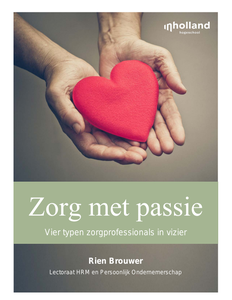In vervolg op onze eerdere publicatie “Werk verandert” (Biemans, Sjoer, Brouwer en Potting, 2017) waarin wij een beeld gaven over het toekomstig werk als verpleegkundige geven wij in deze publicatie een impressie van de ontwikkelingen die spelen bij een viertal specialistische beroepen in zorg en welzijn. Deze vier beroepen zijn achtereenvolgens: de verpleegkundige ouderenzorg, medisch beeldvormings- en bestralingsdeskundige (hierna MBB’er), psychiatrisch verpleegkundige en de maatschappelijk werker.
DOCUMENT

Lectorale rede bij de aanvaarding van het ambt van lector Medische Technologie Medische Technologie is een zeer breed begrip dat reikt van infuuspompen tot operatierobots tot lineaire versnellers, et cetera. In het vorige hoofdstuk is al uit de doeken gedaan waar het lectoraat Medische Technologie zich specifiek op richt: medische beeldvorming, radiotherapie en ICT in de zorg. Dat is bij elkaar een zeer breed vakgebied waarvan het lectoraat niet alle facetten kan bestrijken. Daarom richt het lectoraat zich op ontwikkelingen op die terreinen die belangrijke veranderingen in het werkproces teweeg kunnen brengen. Dat zijn de onderwerpen die van belang zijn voor de toekomstige Zorgprofessional 2.0. Hieronder worden de verschillende vakgebieden nader geïntroduceerd en er worden een aantal voor de Zorgprofessional 2.0 belangrijke historische trends beschreven. Samenvattend kan gesteld worden dat het lectoraat Medische Technologie zich heeft ontwikkeld van een specialistisch op radiotherapie gericht lectoraat, naar een breder op medische beeldvorming, radiotherapie, ICT in de zorg en eHealth georiënteerd lectoraat dat op diverse, met name gezondheidszorggerelateerde, terreinen een bijdrage levert aan de opleidingen van Hogeschool Inholland. De bijdrage van het lectoraat Medische Technologie heeft daarbij als doel afstudeerders van diverse studierichtingen op te leiden tot wat in deze rede wordt aangeduid met Zorgprofessional 2.0. Hiermee wordt in deze rede een beroepsbeoefenaar bedoeld die openstaat voor (ICT/technische) innovatie, die zorgconsumenten daarover kan adviseren en die innovatie in de beroepspraktijk weet te implementeren. Praktijkgericht onderzoek speelt daarbij een centrale rol: het draagt bij aan de onderzoekende blik van de Zorgprofessional 2.0, aan het up-to-date houden van de kennis van docenten en studenten en aan de verbinding met het werkveld.
DOCUMENT

Jaarlijks worden 175 baby’s geboren met een klompvoet. Na een aantal behandelingen kunnen zij vaak goed mee. Maar sommige kinderen hebben de pech dat de voet opnieuw vergroeit. Wat zijn daarvoor de eerste aanwijzingen en kun je op het schoolplein al zien bij wie het misgaat?
DOCUMENT
Dit project richt zich op de integratie van Point of Care Technology (POCT), specifiek mobiele spierechografie, binnen prehabilitatie om de fysieke en mentale fitheid van patiënten voor een operatie te optimaliseren en complicaties te verminderen. Het project wordt uitgevoerd in samenwerking met Nij Smellinghe, UMCG, Hanze en Radboudumc. Het doel is om gepersonaliseerde behandelingen voor patiënten te ontwerpen, uit te voeren en te monitoren, waarbij spierechografie wordt ingezet om de spierstatus van patiënten nauwkeurig te beoordelen. Het project is opgedeeld in vier werkpakketten: 1. Ontwerpfase: Ontwikkeling en validatie van een echografieprotocol dat interprofessioneel kan worden toegepast. Dit protocol wordt getest op betrouwbaarheid en validiteit, en de toepasbaarheid door diëtisten en fysiotherapeuten wordt geëvalueerd. 2. Testfase: Onderzoek naar de toegevoegde waarde van spierechografie binnen het bestaande prehabilitatie protocol. Een cohortonderzoek wordt uitgevoerd bij patiënten die een heup- of knieoperatie ondergaan, om te bepalen of de nieuwe methode effectiever is in het voorspellen en voorkomen van complicaties. 3. Klinische relevantie: Evaluatie van de impact van spierechografie op klinisch redeneren en het bijsturen van prehabilitatie-interventies. Dit wordt onderzocht via cohort- en kwalitatief onderzoek, waarbij de ervaringen van zowel zorgverleners als patiënten worden meegenomen. 4. Implementatievoorbereiding: Identificatie van kritische determinanten voor succesvolle implementatie van spierechografie in de dagelijkse praktijk. Dit werkpakket resulteert in een scholingsprogramma voor zorgprofessionals en een implementatieplan voor brede adoptie. Het project beoogt de ontwikkeling van een interprofessionele leergemeenschap waarin praktijk, onderwijs en onderzoek samenwerken aan innovatie in prehabilitatie, met als einddoel het verbeteren en toekomstbestendig maken van de zorg rondom operaties.
STEADY; Sustained Technology for Evaluation of lumbar Atrophy and DYsfunction Aspecifieke lage rugpijn (aLRP) is als aandoening lastig te begrijpen en te behandelen. De zorgconsumptie en het arbeidsverzuim ten gevolge van deze aandoening is hoog. De fysiotherapeut staat voor de maatschappelijke uitdaging de meest effectieve en efficiënte behandeling voor patiënten met aLRP toe te passen, waarbij het vaststellen van subgroepen van patiënten één van de internationale speerpunten van onderzoek is. Op dit moment wordt het gebruik van technologie voor de diagnostiek van aLRP niet algemeen in de fysiotherapie gebruikt. Dit project heeft als hoofddoelstelling innovatieve technologie te gebruiken en te optimaliseren om de diagnostiek van aLRP door de fysiotherapeut te verbeteren. Diagnostische technologie voor het meten van functie (kracht, coördinatie, bewegingspatronen) en morfologie (spierkwaliteit) van de wervelkolom musculatuur wordt gevalideerd voor het classificeren van subgroepen van aLRP-patiënten. Het innovatieve element van STEADY is het inzetten van technologie in de dagelijkse fysiotherapiepraktijk ten behoeve van objectieve classificatie. STEADY bevindt zich op het snijvlak van techniek en gezondheid. STEADY bestaat uit een samenwerkingsverband tussen het publieke fysiotherapeutische domein, twee hogescholen, een buitenlandse universiteit, een universitair medisch centrum, een technische universiteit, diverse perifere kennisinstellingen en het MKB.